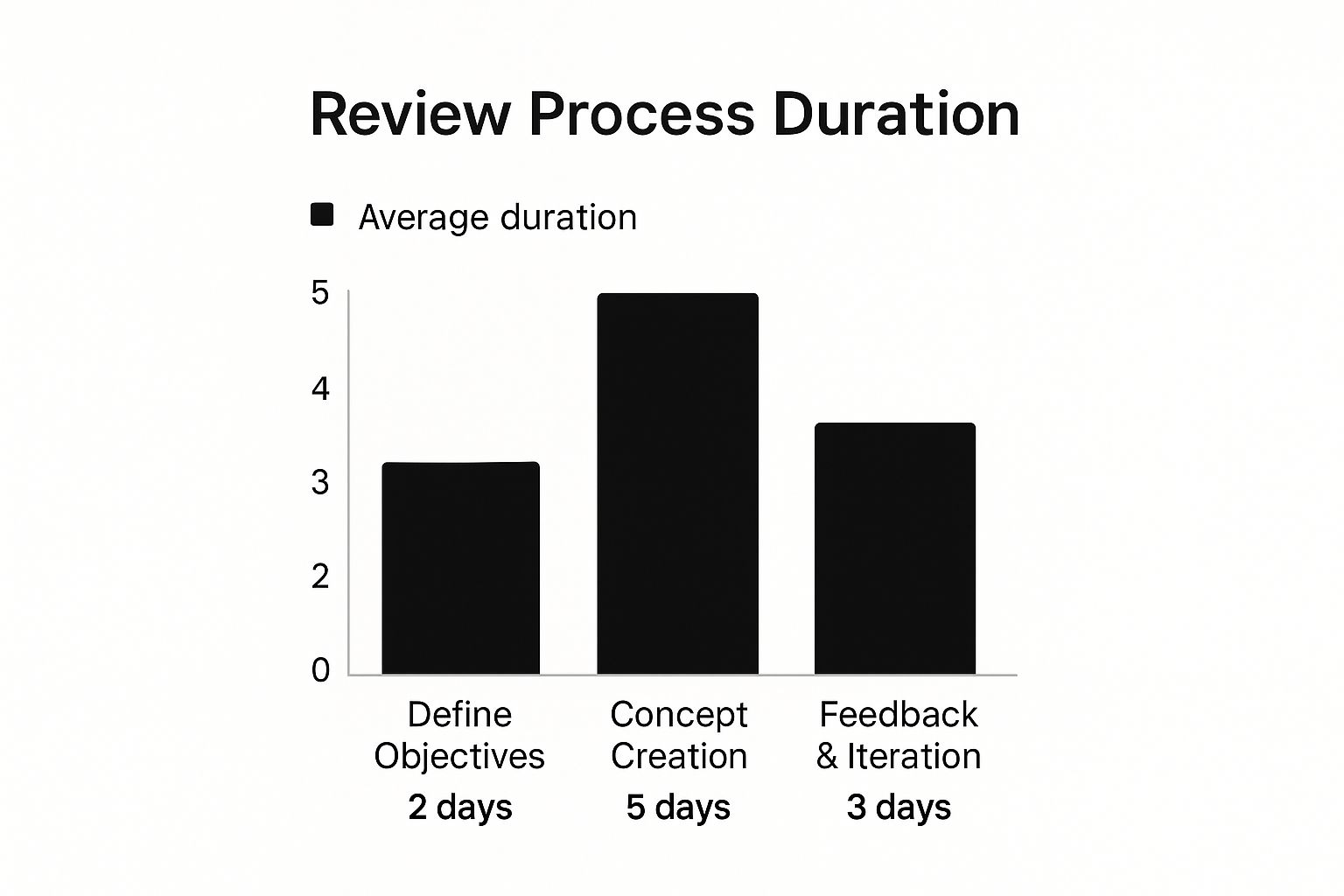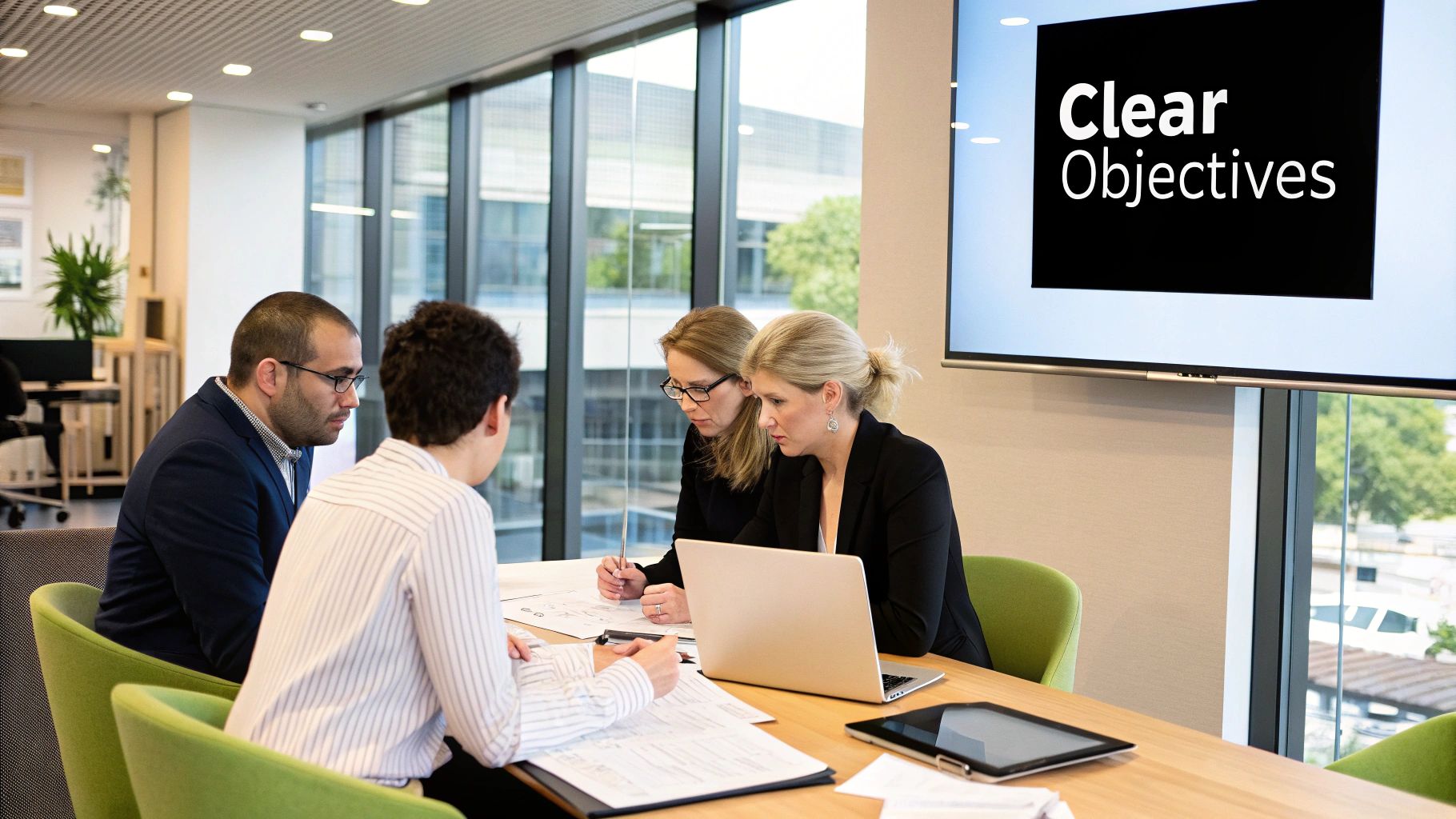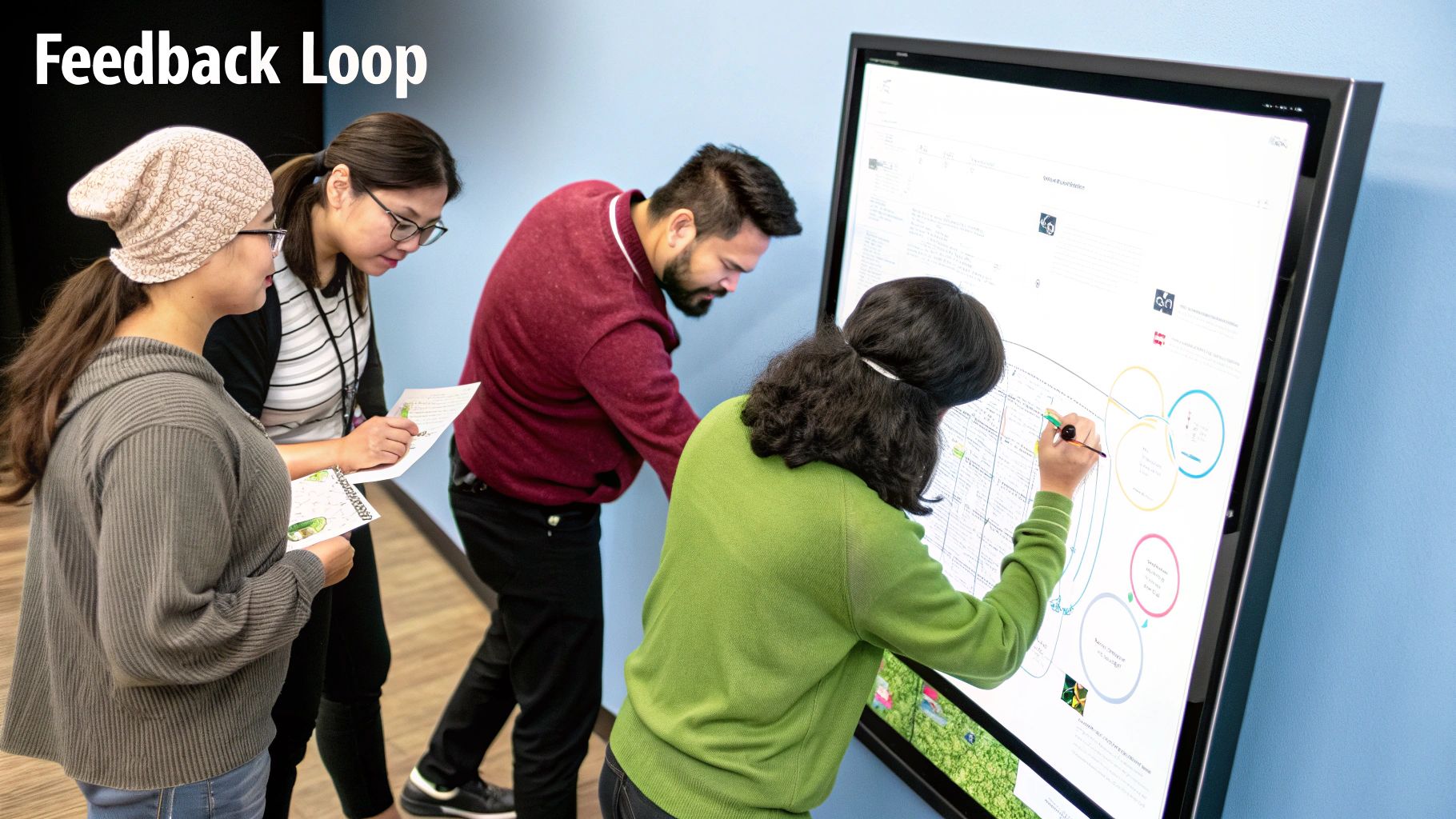The Evolution of Creative Review in the Digital Age

Creative reviews used to mean crowded rooms and countless sticky notes. Now, things are different. The rise of remote work and tools like Filestage have changed how teams create, give feedback, and revise projects. This new way of working offers exciting possibilities, but also comes with its own set of challenges.
The data chart above illustrates key metrics related to the adoption of digital creative review processes, specifically client satisfaction, revision cycles, and time to project completion. As you can see, embracing digital tools has led to significantly improved client satisfaction and a reduction in both revision cycles and project completion time.
By 2023, three-quarters of creative collaboration happened remotely. Interestingly, 74% of this remote work still took place in real time. This shows how important digital tools have become for communication and feedback. There's still room to grow, though. Using AI and automation can make feedback even more efficient. You can find more statistics in the Filestage Creative Collaboration Report.
Navigating the Shift to Digital
This change from in-person meetings to online feedback requires a new way of thinking. Teams need to adjust to asynchronous communication, using tools that make feedback clear even when people are in different time zones. Having clear guidelines for communication and feedback is also essential for efficiency and avoiding confusion.
Balancing Efficiency and Creativity
A major challenge is balancing a streamlined review process with the freedom to be creative. Teams need to be careful not to let strict rules stifle innovation. Instead, digital tools should boost creativity, allowing for quicker revisions and more dynamic feedback. Tools that allow for real-time annotations, version control, and collaborative brainstorming can help achieve this.
The Impact on Creative Output
The move to digital reviews has a real impact on the final product. Studies show a link between effective digital reviews and happier clients. There's also been a 15% drop in revisions when using collaborative review platforms instead of traditional methods. This shows that digital tools can improve both quality and efficiency.
Traditional vs. Modern Creative Review
To illustrate the key differences between traditional and modern approaches, let’s take a look at this comparison:
| Review Aspect | Traditional Approach | Modern Digital Approach | Key Benefits |
|---|---|---|---|
| Location | In-person meetings | Online platforms, cloud-based systems | Increased flexibility, accessibility |
| Feedback Delivery | Verbal comments, printed annotations | Digital annotations, comments, threaded discussions | Clearer communication, reduced misinterpretations |
| Version Control | Difficult, often reliant on manual tracking | Automated versioning, easy comparison of revisions | Prevents errors, streamlines iteration |
| Time Efficiency | Time-consuming meetings, potential for delays | Faster turnaround times, asynchronous feedback | Increased productivity, quicker project completion |
This table clearly highlights the advantages of modern digital review processes, especially in terms of flexibility, clarity, and efficiency.
This change in creative reviews is more than just about technology. It’s a fundamental shift in how teams work together and create. By using the potential of digital tools and adapting to this new environment, creative teams can become more efficient and produce even better work. This opens up exciting possibilities for developing new frameworks that support this digital approach.
Building a Framework That Actually Works

A well-structured creative review process is essential for successful projects. It moves teams beyond disorganized feedback and into a clear, productive system. This framework guides the project from initial idea to final product, ensuring everyone understands their role and contributes effectively.
Defining Clear Review Stages
A successful review process begins with defined stages. This manages expectations and keeps the project on track.
-
Initial Concept: This stage focuses on brainstorming and developing the core idea. It's where creativity and exploration thrive.
-
First Draft: The initial concept becomes a tangible piece of work. This could be a design, written content, or a video.
-
Internal Review: The team reviews the first draft, provides feedback, and makes revisions. This ensures internal alignment before client presentation.
-
Client Presentation: The refined draft is presented to the client for their input and feedback. This is a crucial step for collaboration and ensuring client satisfaction.
-
Finalization: Based on client feedback, final adjustments are made, and the project is completed. This stage polishes the work and prepares it for delivery.
Each stage has specific inputs and outputs for a seamless workflow.
Establishing Roles and Responsibilities
Clear roles are vital. Each team member needs to know their responsibilities in the review process. This avoids confusion and keeps things moving smoothly. For example, a project lead oversees the process, a creative director provides artistic guidance, and a client liaison manages client communication.
Setting Realistic Timelines
Creative work requires time. Realistic deadlines are essential for a healthy review process. Rushed timelines lead to burnout and subpar results. Include buffer time for revisions and unforeseen delays. Respect the creative process while meeting client needs.
Implementing Effective Feedback Protocols
Feedback is central to any creative review. It must be constructive and manageable. Establish clear protocols for giving and receiving feedback. Consider using tools like Creativize for streamlined feedback collection. Ensure comments are specific, actionable, and focused on improvement. This prevents excessive revisions and maintains a positive environment. Studies show a structured feedback process can reduce revision rounds by as much as 50%, saving time and resources. A well-defined process, like the one Creativize supports, contributes significantly to this improvement.
By focusing on these core elements, you can build a truly effective creative review process. This fosters collaboration, improves creative output, and strengthens client relationships. A strong framework is the key to unlocking creative success.
The Tools That Transform Creative Feedback
A strong framework for creative review is essential. However, the right tools can truly elevate the process. Moving beyond basic project management software opens up a world of specialized platforms designed for creative teams. These platforms offer features that streamline feedback, manage versions, and ultimately, improve the final product. But how can you choose the tools that truly deliver?
Essential Features for Creative Review Tools
The core purpose of any creative review tool is facilitating clear, efficient, and actionable feedback. This means features like annotation tools are crucial. These tools allow reviewers to pinpoint specific elements within a design, image, or video and leave precise comments. This eliminates vague feedback and ensures everyone understands the required revisions.
Version control is another key element. It tracks every iteration, allowing easy comparisons between versions and reverting to previous stages when necessary. This prevents wasted time and keeps projects moving forward. Additionally, centralized feedback collection keeps all comments organized in one location. This eliminates scattered emails and confusing conversations, promoting transparency and team alignment.
Evaluating Your Options: Finding The Right Fit
Not all creative review tools are created equal. Some offer robust features for large agencies managing complex campaigns, while others are better suited for smaller teams with simpler projects. Choosing the right tool depends on your specific needs. Consider your team's size, project types, and budget. A powerful platform with advanced features might be overkill for a small team, while a basic tool may not suffice for a larger agency.
To help you evaluate options, we've compiled a comparison table highlighting some popular platforms:
Before diving into the table, let's briefly discuss the growing importance of creative management platforms (CMPs). These platforms streamline content creation, collaboration, and feedback.
Popular Creative Review Tools Comparison
| Platform | Best For | Standout Features | Limitations | Pricing Model |
|---|---|---|---|---|
| Creativize | Creative teams needing streamlined feedback and project management | Annotation tools, version control, centralized feedback | Limited integrations with other platforms | Subscription-based |
| Filestage | Marketing teams and agencies managing complex approval workflows | Customizable workflows, advanced security features | Can be complex for smaller teams | Subscription-based |
| Frame.io | Video production teams requiring real-time collaboration | Real-time feedback, frame-accurate annotations, version comparison | Primarily focused on video content | Subscription-based |
| Wrike | Large teams managing complex projects across departments | Customizable dashboards, Gantt charts, resource management | Can be expensive for smaller teams | Subscription-based |
| ProofHub | Teams prioritizing simplicity and ease of use | Centralized communication, task management, file sharing | Limited advanced features | Subscription-based |
This table offers a quick glance at several leading tools. Remember to research each platform thoroughly to determine the best fit for your team.
Implementation and Adoption: Smoothly Integrating New Tools
Introducing new tools requires careful planning and execution. Involve your team in the selection process to gain buy-in and ensure smooth adoption. Understanding their needs and preferences is key. Starting with a pilot program with a smaller group allows you to identify any challenges and refine your implementation strategy. Don't forget to provide training and support to help your team fully embrace the new platform.
Real-World Examples: Tools in Action
Creativize offers streamlined feedback collection and project management features designed specifically for creative teams. Many teams find success with tools offering real-time collaboration features, enabling instant feedback and immediate revisions. Others benefit from platforms that integrate with existing project management systems, creating a seamless workflow. By examining real-world examples, you can learn valuable lessons and optimize your approach.
Choosing the right creative review tools can significantly enhance your team's efficiency and the quality of your creative output. Carefully considering your needs and exploring the available options can transform your creative review process from a potential bottleneck into a powerful engine for innovation.
Feedback That Inspires Rather Than Deflates

The creative review process is more than just a checklist; it's about nurturing creativity and building a bridge between concept and final product. However, feedback delivered poorly can stifle innovation and negatively impact team morale. Turning this process into a positive one requires understanding the human aspect of feedback and using strategies that encourage growth.
The Psychology of Effective Creative Feedback
Creative work is often deeply personal. Because of this, feedback can sometimes feel like a personal attack, leading to defensiveness. Effective feedback focuses on the work itself, not the individual. This means framing comments constructively and concentrating on specific areas for improvement. For example, instead of saying "This design is messy," try "The layout could be improved by grouping these elements together."
Structuring Feedback for Maximum Impact
A clear structure helps improve understanding and minimizes miscommunication. Consider using a framework, such as the one provided by Creativize, which promotes a more structured approach to giving feedback.
- Observation: Begin by describing what you see objectively. For example, "The main headline uses a sans-serif font."
- Implication: Explain the impact of your observation. "The sans-serif font makes the headline feel less formal."
- Suggestion: Provide a concrete suggestion for improvement. "Consider using a serif font for a more sophisticated look."
This structured approach keeps feedback focused and actionable.
Language That Encourages Collaboration
The language used during creative reviews significantly impacts the entire dynamic. Phrases like "I wonder if…" or "Have you considered…" foster a sense of exploration and collaboration. These open-ended questions encourage creatives to explore alternatives without feeling pressured. Framing feedback as questions also opens the door for dialogue and mutual understanding.
Navigating Tricky Feedback Situations
Not every feedback scenario is simple. Sometimes, stakeholders have differing opinions or grapple with subjective aesthetic disagreements. In these situations, facilitating open discussion and finding common ground is essential. Consider creating a space within Creativize where stakeholders can share their perspectives and reach a consensus. This fosters collaborative problem-solving and ensures every voice is heard.
Another common challenge comes from feedback given by non-creative stakeholders. They may not fully understand the creative process, sometimes leading to impractical suggestions. Explaining the reasoning behind creative decisions helps bridge this gap. Patience and clear communication are key in these situations.
Real-World Examples: Turning Feedback into Fuel
One marketing agency reported a noticeable increase in client satisfaction after implementing a structured feedback framework. By prioritizing clear communication and collaborative discussions, they shortened revision cycles and built stronger client relationships. Another example involves an in-house team that struggled with conflicting feedback. Using Creativize to centralize feedback and facilitate discussion streamlined their review process and boosted team morale.
Mastering the human side of creative reviews transforms feedback from a potential source of frustration into a valuable tool for growth. This approach not only improves the final product but also strengthens the team’s overall creative capacity. By using constructive language, structured frameworks, and platforms like Creativize, creative teams can cultivate a culture of continuous improvement and achieve exceptional results. This, in turn, strengthens client relationships and fosters a more rewarding creative process.
Scaling Your Creative Review Process As You Grow

Growth is exciting for any creative team. However, expanding your team and client list often puts a strain on your creative review process. Maintaining quality and efficiency becomes more complex as you scale. Your review process must adapt to handle the increased volume without sacrificing the quality of your output.
This section explores how successful creative operations leaders manage this growth. We’ll look at strategies for maintaining efficiency and quality while keeping projects on track.
Managing Multiple Simultaneous Projects
Handling multiple projects at once demands a structured approach. Think of a project manager like an air traffic controller. Clear communication and well-defined processes are essential for preventing collisions. Similarly, prioritizing projects based on deadlines and strategic importance keeps your creative projects moving smoothly.
Project management software, or a dedicated platform like Creativize, is invaluable for organizing tasks and tracking progress. Centralizing communication for each project ensures nothing gets lost in the shuffle and resources are allocated efficiently. This level of organization is key to successful scaling.
Implementing Tiered Review Structures
As your team grows, a one-size-fits-all review process may not be suitable. A tiered review structure, where the review stages vary based on project complexity, offers a more adaptable solution. Smaller projects might only need a quick internal review.
Larger projects, however, benefit from multiple stages and client input. This tiered system ensures that appropriate resources are dedicated to each project, preventing unnecessary bottlenecks and delays. This allows for a more streamlined and efficient workflow.
Maintaining Consistency Across Creative Outputs
Consistency is paramount for brand identity and client satisfaction. This becomes even more critical as your team expands and the volume of creative work increases. Clear brand guidelines and using templates within Creativize can help maintain a unified look and feel.
Regular feedback sessions ensure everyone understands and consistently applies these guidelines. This fosters a shared understanding of the brand's visual language and strengthens the overall quality of your creative output.
Onboarding New Team Members and Leveraging Technology
Efficient onboarding is vital for scaling your creative review process. Clear documentation and training on your review protocols and tools like Creativize ensure new members become productive quickly. This also ensures adherence to established standards from the start.
Automating repetitive tasks frees up your team to focus on more strategic work. Templates for feedback forms and automated notifications for deadlines streamline the process and reduce administrative overhead. This allows for more efficient use of time and resources.
The creative review process is increasingly important as demand for high-quality content grows. The global creative services market was valued at USD 3.167 billion in 2024 and is projected to reach USD 5.353 billion by 2031, growing at a CAGR of 6.78%. This growth highlights the need for efficient review systems. You can find more detailed statistics here: https://www.verifiedmarketresearch.com/product/creative-services-market/
Addressing the Challenges of International Scaling
International scaling presents unique challenges for creative reviews. Different cultures have different communication styles and feedback preferences. Cross-cultural training for your team helps navigate these nuances.
Implementing strategies for effective time zone management, such as asynchronous feedback tools and flexible meeting schedules, ensures smooth collaboration across geographically dispersed teams. By adapting your process and utilizing technology like Creativize, you can maintain a high-quality creative review process, regardless of location. Building a system that's both adaptable and robust is key to scaling your creative review process and meeting the demands of a global market.
Measuring What Actually Matters in Creative Reviews
A well-structured creative review process is essential. But how do you measure its effectiveness? Simply having a process isn't enough. You need to track its impact and pinpoint areas for improvement. This means measuring key metrics that offer real insights into how well your process is working. Data-driven decisions, not guesswork, are key to optimizing your creative workflow.
Quantitative Measures: Tracking the Tangible
Quantitative measures provide the hard data you need to track progress and identify bottlenecks. For example, time-to-approval measures how long it takes for a creative asset to move through each review stage. Tracking this can uncover delays and inefficiencies. Revision frequency is another important metric. A high number of revisions could signal unclear feedback or miscommunication during the review process.
Keeping track of these metrics offers valuable insights into your team’s efficiency. It also highlights areas ripe for improvement. A platform like Creativize can be helpful for managing these quantitative measures, tracking approvals and versions, and gauging the effectiveness of your review cycles.
Qualitative Indicators: Assessing the Intangible
Numbers are important, but they only tell part of the story. Qualitative indicators offer a deeper understanding of the human side of creative reviews. Stakeholder satisfaction measures how happy clients and internal teams are with the process. This can be gauged through surveys or feedback tools, often available within platforms like Creativize.
Creative quality assessments are also crucial. This involves evaluating the final product against set criteria, such as originality, effectiveness, and brand alignment. While these assessments can be subjective, they provide essential insights into how the review process impacts the creative work itself. Research from The BetterIdeas Project reveals that only 10% of ideas are evaluated against clearly defined criteria, emphasizing the need for robust assessment measures.
Implementing Tracking Systems and Setting Baselines
Setting up tracking systems doesn’t need to be complex. Start by selecting a few key metrics aligned with your specific goals. A platform like Creativize can simplify this process. Establish realistic baselines for comparison by collecting data on your current process before making any changes. This baseline data serves as a benchmark to measure the effectiveness of future adjustments.
Setting Achievable Targets and Demonstrating Impact
Once you have a baseline, set achievable targets for improvement. For example, aim to reduce time-to-approval by 10% or lower revision frequency by 15%. These targets give your team concrete goals to strive for. Tracking your progress against these targets lets you demonstrate the real-world impact of an optimized review process. This data is especially useful when presenting to leadership or justifying investments in process improvements.
Case Studies and Real-World Examples
Many agencies and in-house teams have achieved substantial improvements by tracking and analyzing their creative review processes. Some have used this data to identify bottlenecks and justify the implementation of new tools like Creativize. Others have shown a direct correlation between a more efficient review process and higher client satisfaction. Learning from these real-world examples allows you to adapt successful strategies to your own team's needs.
Matt Davies and Pieter-Paul von Weiler, through The BetterIdeas Project, discovered that it takes an average of five rounds of creative development to finalize an idea. This highlights the need for a more streamlined review process. Their research also indicates that creative agencies are only proud of 26% of their work. Measuring and optimizing the creative review process is a key step towards increasing this number. By focusing on what truly matters, you can transform your creative review process from a necessary step to a catalyst for creative excellence.
The Future of Creative Review: AI's Growing Role
The creative review process, once synonymous with sticky notes and packed conference rooms, is changing. While tools and frameworks already exist to improve collaboration and feedback, the next big step is integrating Artificial Intelligence (AI). This technology has the potential to reshape how we create, refine, and evaluate creative work. This section explores how AI and automation are poised to change the creative review process, examining both the exciting possibilities and the practical considerations for implementation.
AI-Powered Feedback Analysis: Deciphering the Patterns
Imagine AI analyzing feedback from multiple stakeholders, identifying recurring themes and potential disagreements. This is now a reality. AI-powered feedback analysis tools can sift through comments, categorize them by topic, and even gauge sentiment. This allows creative teams to quickly grasp core concerns and prioritize revisions, saving valuable time and minimizing miscommunication. This technology translates disparate feedback into clear, actionable insights.
Automated Quality Checks: Catching Errors Before They Escalate
AI also plays a vital role in quality control. Automated checks can scan creative assets for technical errors, inconsistencies, or deviations from brand guidelines. For instance, AI could flag an image with incorrect resolution or text that doesn't match the brand voice. This catches problems early in the review process, before they reach the client, saving time and preventing expensive rework.
Predictive Tools: Anticipating Audience Reception
One of the most fascinating applications of AI in creative review is predictive tools. These tools analyze past campaign data, audience demographics, and current trends to predict audience reactions to different creative concepts. While still developing, this technology has the potential to change how creative decisions are made by providing data-driven insights that complement creative intuition. This helps creatives understand what resonates with their target audience, leading to more effective campaigns.
Human Judgment vs. Automation: Finding the Right Balance
While AI offers enormous potential, human judgment remains crucial in the creative review process. AI excels at identifying patterns and automating repetitive tasks. However, human creativity, intuition, and understanding of context are still essential. The future of creative review lies in finding the right balance between AI-powered tools and human expertise. As Marketoonist Tom Fishburne suggests, the creative process requires a human editor to guide feedback and make final decisions, emphasizing the importance of human input even with AI advancements.
Preparing Your Team for an AI-Powered Future
Integrating AI into your creative review process requires careful planning. Start by educating your team about AI’s benefits and limitations. This helps reduce concerns about job displacement and encourages embracing new technologies. Focus on how AI can augment, not replace, creative skills. Encourage your team to develop critical thinking, adaptability, and collaboration. These skills will become even more important as AI handles more routine tasks, allowing creative professionals to focus on strategic and conceptual work, ultimately increasing their value.
Practical Considerations for Implementation
When implementing AI tools, start small. Choose one area of your creative review process, such as feedback analysis or quality control, and pilot an AI solution. This allows you to evaluate its effectiveness and gather team feedback before full integration. Consider using a platform like Creativize which integrates with AI tools, providing a central hub for managing your creative review process.
The future of creative review is collaborative, data-driven, and increasingly automated. By embracing AI and preparing your team, you can unlock new levels of efficiency and creative excellence. Remember, the goal is not to replace human creativity, but to enhance it with the power of AI. This empowers creative teams to focus on what they do best: imagine, create, and inspire.
Ready to improve your team’s creative process? Explore how Creativize can streamline your creative review, from initial concept to final delivery. Connect with local talent, manage feedback efficiently, and unlock your team's full creative potential with Creativize.

